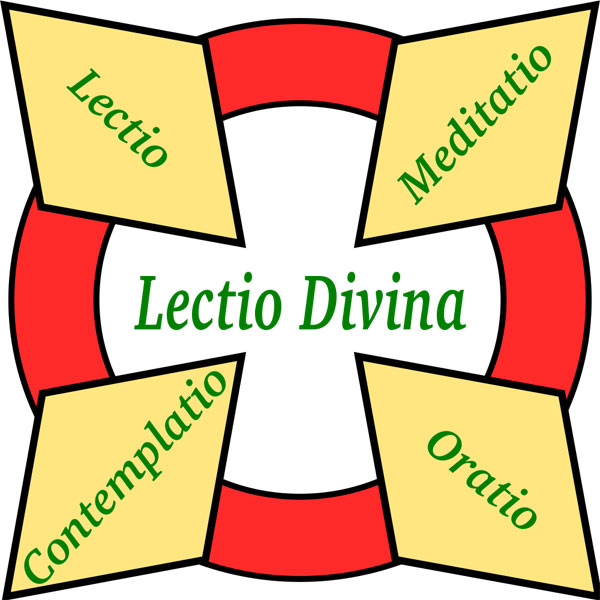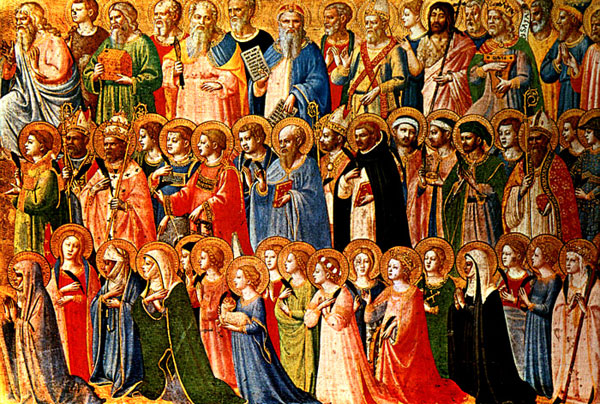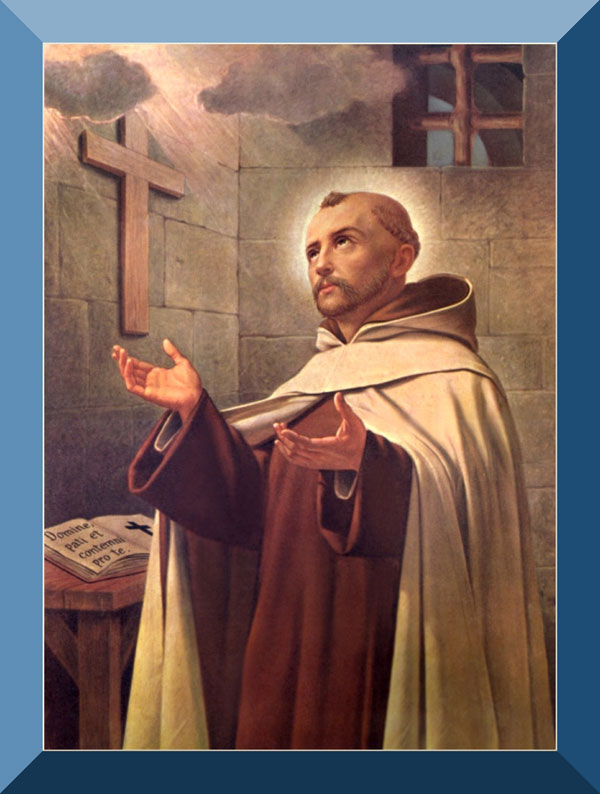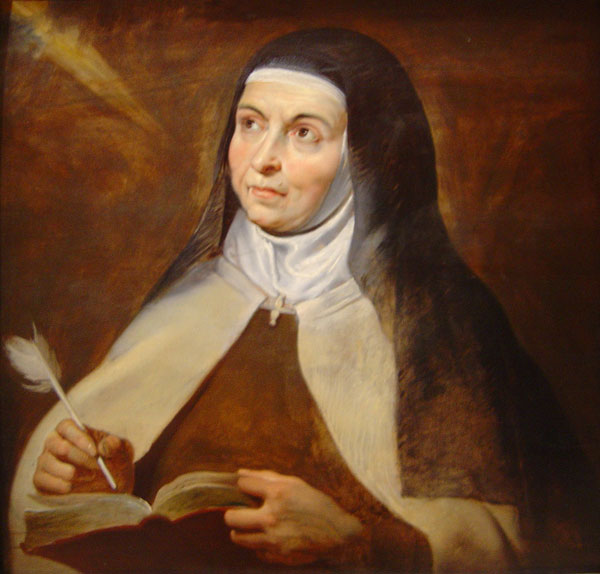Elements of Mystic tradition: The “Lectio Divina”
Now considered to be a staple of the Christian mystic tradition, the “Lectio Divina”” can be seen as a form of contemplative prayer in which the practitioner reads scripture with the specific intent of creating a mystic union with God.
This is done not by focusing on the words of the passage that one reads, but by physically experiencing the message of the text. In order to properly accomplish this, it is recommended that one follow the steps of the author Guigo II, who turned the practice into a four step process in the 12th century. These guidelines provide a blueprint for the believer who wishes to practice the “Lectio Divina”, they include: reading, meditation, prayer, and contemplation.
- Reading: In the first step of this contemplative exercise, the practitioner is encouraged to read the scripture. In preparation for this, the believer is instructed to enter a tranquil state of mind. Once this has been achieved, it is recommended that the selected passage be read multiple times.
- Meditation: At the heart of this mystic practice is meditation. This requires that the believer listen for the message of the scripture as delivered by God.
- Prayer: An integral step in achieving a mystic union with God, prayer allows for the believer to communicate with God in order to hear the message of the text.
- Contemplate: The final step in this endeavor, contemplative thought occurs after the process is complete in order to reflect on the message God has given the believer.
For the believer who wishes to gain a mystical union with God, the “Lectio Divina” allows for the quiet of thought to be an avenue for God to speak directly to the believer. It is for this reason that this method of reading scripture has become a mainstay of the Christian mystic tradition.
The Process of Canonization for Catholic Saints
The Catholic Church defines canonization as the official process by which one is made a saint. Early in church history, those who were considered Catholic saints would be placed in tombs that would be considered sacred. When the quality of those granted sainthood was called into question, it was decided that more care should be taken as to who was worthy of this honor.
This idea developed through the centuries, culminating in the establishment of an official process to investigate sainthood eligibility by Pope Gregory XI in 1234.
Though popes throughout church history have revised the qualifications one must meet in order to be named among the Catholic saints, the core process has remained constant. The process for establishing sainthood begins when a person dies who has fame of sanctity.
When this occurs, their life is investigated by a bishop, who evaluates whether they are deserving of being named among the Catholic saints. If this person is found worthy, their information is sent to the Congregation for the Causes of the Saints, which attempts to establish if the person lived according to the virtues of faith.
If the candidate satisfies these requirements, he or she may be considered venerable. Throughout this process, a devil’s advocate, or person who argues against canonization, is commissioned.
The final step in the process of being named among the Catholic saints is beatification. In order to become beatified, the candidate must be credited with a miracle. This will grant the candidate restricted veneration. After this is established, the recognition of a second miracle is required for the candidate to be called among the Catholic saints.
Throughout Church history, the proof of miracle has been a requirement for all that are selected for candidacy, aside from martyrs, who may be canonized without proof of a miracle.
The Mystic Saints: Clare of Assisi
Founder of the contemplative “Order of Poor Ladies” with the help of Francis of Assisi, Clare spent the majority of her life in imitation of Francis and his order, seeking above all else a life of poverty and charity in the Christian mystic tradition. Canonized in 1255, Clare’s devotion to asceticism for herself and her order saw her in conflict with the Catholic Church on more than one occasion; however, she was ultimately praised by the church for her unwavering Catholic spirituality.
In recognizing her mystic qualities, the Catholic Church deemed Clare the patron saint of television in 1958, a title which celebrates her connection to the Holy Spirit, which was said to project a vision of the daily mass on the wall of her room when she was too sick to psychically attend.
In a manner similar to her future mystic mentor, Claire of Assisi grew up a child of a wealthy family in Assisi. However, unlike Francis of Assisi, her ardent commitment to Catholic spirituality and contemplative living was evident at an early age. Perhaps taking after her mother, who was said to be a pious and god-fearing woman, Clare was seen as a young girl to be uninterested in the practices of the world at large, preferring mystic endeavors, such as mortification.
This early desire to imitate the passion of Jesus can be seen as a starting point for her Catholic spirituality and a precursor to her eventual commitment to the life of a mystic.
Soon after these early signs of devotion, Claire’s desire to pursue a contemplative life and achieve a mystic union with God took hold. When she was 18 years old, Clare heard Francis of Assisi preach at a local church. As he spoke, Clare felt the presence of the Holy Spirit burn inside of her. Being greatly inspired by his message, Clare requested that Francis help her grow stronger in her Catholic spirituality. In recognizing the sincerity that accompanied her words, Francis agreed to assist her.
In what was another display of her devotion to the mystic and contemplative lifestyle that lay before her, Clare left her father’s house in secret in order to provisionally join an order of Benedictine nuns. When her father heard of this, he went to the covenant and attempted to physically remove her from the premises. However, Clare resisted, and with seemingly no other options, her father left her in peace. This courageous act further displayed Clare’s commitment to her Catholic spirituality, as she would soon enter into a welcomed life of contemplative living and austerity on her path to achieving a mystic union with God.
As more people began to follow Clare’s example of shunning the world at large in order achieve a mystic union with God, Francis decided that Clare and those who followed her should take on an order of their own. With their stationing by Francis at an adjoining building of the Chapel at San Domino, the contemplative “Order of Poor Ladies” was born. Early on, it was the intention of Clare and her covenant to live in imitation of the mystic order of the Franciscans, which meant a life of poverty and charity.
However, the church at this time felt this was not suitable for women, and as such attempted to deny the right of the order to live a life of poverty. Finding this incompatible with her Catholic spirituality and mystic endeavors, Clare, in a meeting with Pope Gregory XI, remarked that in living in poverty, she was fulfilling her obligation to Jesus Christ. This desire to follow in the mystic and contemplative tradition of the Franciscans inspired the pontiff, and led to the granting of her request.
Towards the end of her life, Clare experienced perhaps her most famous mystic endeavor, as she is said to have thwarted the advance of rival forces intent on terrorizing the chapel simply by lifting a ciborium over her head. This final mystic experience grew Clare’s reputation as a woman of great Catholic spirituality. The heroism displayed in this action solidified Clare as a woman of great and love and devotion, which may be said to be her greatest imitation of the life of Jesus.
The Mystic Saints: John of the Cross
Perhaps the most revered of all the mystic saints, John of the Cross’s unquestioned devotion to a lifestyle of contemplative thought and rigorous asceticism makes him a prime example of what it means to be strong in Catholic spirituality. A prolific and celebrated writer, John of the Cross endured a life of turmoil in his unwavering pursuit of a union with god. A co-founder of the Discalced Carmelite Order along with fellow mystic St. Teresa of Avila, John of the Cross was elevated to sainthood in 1726 and was later made a doctor of the church for his contributions to ascetic and contemplative life. The persistence John showed by continuing to live the life of a mystic in the face of his hardships makes him something of a role model for those who wish to strengthen their Catholic spirituality.
Born in Spain in 1542, St. John of the Cross grew up without much money after the death of his father left the family struggling to get by. From an early age, the mystic qualities of John of the Cross were evident, as twice during his young life he was said to have been rescued from death through divine intervention. Later, he would continue down the mystic path by tending to lepers at a local hospital, and attending a school of the Society of Jesus. When he was 21 years old, he joined the Carmelite Order, and instantly impressed the friars there with his devotion to contemplative thought and asceticism. This lifestyle of asceticism grew his mystic union with God as well as his Catholic spirituality, and saw him promoted to a priest in the Carmelite Order in 1567.
{Join Now You Know Media’s talented Catholic presenters and enjoy our Catholic Religious Programs on spirituality and prayer, scripture, theology, church history, world religion, and so much more! Learn about the rich history, faithful traditions and sacramental life of the Catholic Church.}
Around this time, St. Teresa of Avila, a Carmelite nun, heard of John’s virtue as a man of great catholic spirituality and wished to meet him. In him, she saw a fellow contemplative mystic whom she believed was the right person to help her reform the Carmelite Order. He agreed, and in his agreement the Discalced Carmelite Order was born. It was soon after this that John‘s mystic union with God rose to new heights, as his continued prayer and solitude made him yearn to imitate the life and sufferings of Jesus. In what would come to be a pattern in John’s life, this feeling of unparalleled joy would soon be replaced by devastation. Though he never lost sight of his mystic endeavors, John began to feel a loss of interiority and Catholic spirituality that he attributed to the work of devils. He would later describe this feeling as a stage all contemplative souls must journey through in order to achieve union with God.
Though he was able to continue his work as a mystic, the hardships that seemed to run concurrent with John’s life did not cease. In 1577, he was imprisoned by revolting members of the Discalced Order, who were opposed to the reforms he and Teresa of Avila had imposed. While imprisoned, John wrote what are considered to be some of his most thoughtful and beautiful works as a mystic. These works, which include “The Ascent on Mount Carmel “and “The Living Flame of Love”, focus on the strengthening of one’s Catholic spirituality through the practice of asceticism. These works reinforce the teachings of St. John of the Cross that in living a contemplative life, it is possible to attain a mystic union with God. Though he did eventually escape his captors, he was ultimately distanced from the Discalced Carmelite Order after a disagreement with his superiors, and lived the remainder of his life in exile.
In many ways, the life of John of the Cross can be seen to be a blueprint for sainthood. Throughout his many years of hardships and setbacks, John eventually came to achieve a mystic union with God through his lifestyle of asceticism and contemplative prayer. In his writings and teachings, St. John of the Cross tells the believer how to experience God more fully, and lays out the path that one must take in order to attain this experience. His countless contributions to the church and Christian mystic thought make him one of the foremost authorities on how to strengthen Catholic spirituality.
For more litterateurs like this please visit Now You Know Media to download mp3 audio and video catholic religious programs and audio video courses.
The Mystic Saints: Teresa of Avila
The spiritual life of the woman known as St. Teresa of Avila was marked by periods of intense mystic ecstasy, followed by the cooling of her Catholic spirituality. This pattern continued fairly regularly into her adult life, until the weight of a certain experience caused her to forever give herself to God.
The patron saint of headache sufferers, St. Teresa of Avila was the co-founder of the Discalced Carmelite Order, which devotes itself to hermitage and contemplative thought. Canonized in 1622, Teresa was the first woman to receive the title of “Doctor of the Church” in 1970. Her life as a contemplative mystic, along with her writings, act as a guide to spiritual development, and make her an excellent teacher for those interested in strengthening their Catholic spirituality.
———————————————————————————————————-
Shop now at Nowyouknowmedia.com for:
Teresa, Teach Us to Pray
By Professor Keith J. Egan, Ph.D.
President, Carmelite Institute
Washington, DC
Includes 12 Lectures (5 CDs) Including Electronic Study Guide CD:
List Price: $89.95
SALE PRICE: $37.95
Click here to buy: Teresa, Teach Us to Pray
———————————————————————————————————-
Even as a young child, there were signs that Teresa would lead the life of a mystic. Fascinated by stories of saints and martyrs, Teresa once attempted to travel to Africa with her brother, in the hope that they would be beheaded by the Moors. Fortunately, they did not get very far before her uncle discovered them. After being safely returned to their mother, Teresa and her brother began to imagine themselves as hermits, building what they imagined to be cells in which they were to be sequestered. In these two early examples, we can see indications that Teresa’s later calling would be that of a contemplative mystic.
When Teresa was fourteen years old, her mother passed away. This could be seen to have a profound effect on her burgeoning Catholic spirituality. Though she did not lose her faith at this time, her newfound interest in things like romance novels, fashion trends, and perfumes were not exactly conducive to the lifestyle of a Christian mystic. Sensing that his daughter was becoming distracted by the flavors of superficiality, he placed her with a covenant of nuns in Avila. Shortly after her integration into the covenant, Teresa was taken ill, and was forced to return home. While in recovery, she happened upon the letters of St. Jerome, some of which contained urgings to the reader to live as a contemplative, hermit, and mystic. It was due to these readings that she officially made her decision to become a nun, and continue her mystic journey into Catholic spirituality.
Shortly after making this decision, Teresa was struck by the same illness that afflicted her a year earlier. During this second stint of convalescence, Teresa was given the book “The Third Spiritual Alphabet” by her uncle. As she read, she learned of a contemplative prayer known as “the prayer of quiet” which, for a brief time, led her to the mystic experience of “the prayer of union” in which her soul was completely absorbed by God. These teachings of contemplation which led to the mystic union between god and believer can be seen as an influence in Teresa’s later works. After her recuperation was complete, she returned to the covenant, but began to fall away from her Catholic spirituality once again due to worldly distractions.
During this time, she used her failing health as a pretext to stop her practice of contemplative prayer. However she would find her faith again in the power of mystic experience. This sort of heating and cooling of her Catholic spirituality would go on for some time, until she was finally struck by a mystic experience that changed her life forever. In recounting this experience, she remarked that an angel had come down from heaven and pierced her with a fiery arrow, which instilled her with the fire of the lord. This can be said to be the experience that forever united her with God.
Though the accounts of her mystic experiences are something to behold, perhaps the most effective way St. Teresa of Avila communicates with those eager to affect their Catholic spirituality is through her writings. These texts, including “The Interior Castle” and “The Way to Perfection” provide the reader who wishes to see prayer as a mystic connection to be achieved with God, with a blueprint to the contemplative lifestyle. Through these works and others, St. Teresa of Avila extolls the virtues of achieving a mystic connection with God.
For more litterateurs like this please visit Now You Know Media to download mp3 audio and video catholic religious programs and audio video courses.




